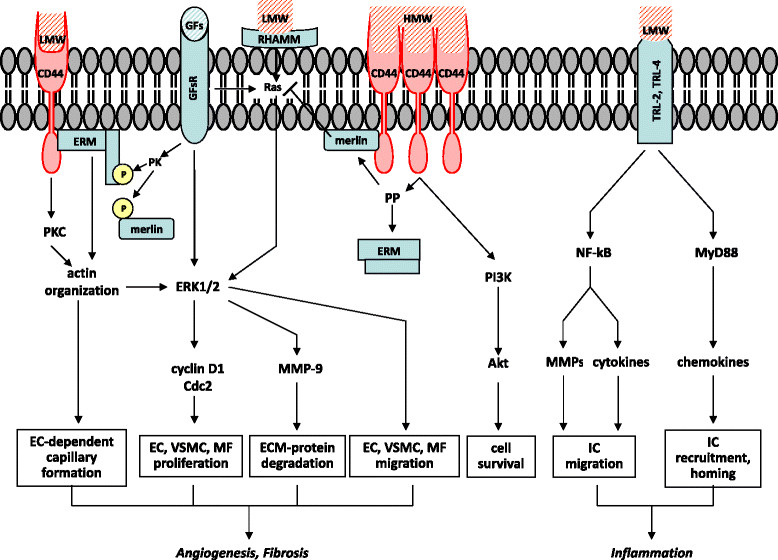Figure 1.

Schematic model showing the possible receptor-mediated signal transduction pathways through which HA of different molecular weights can modulate cell functions. High molecular weight-HA (HMW) and low molecular weight-HA (LMW) differently modulate receptor-mediated cell functions. Endothelial cells (ECs) and vascular smooth muscle cells (VSMCs) interacting with LMW can promote angiogenesis via CD44 and RHAMM transduction signaling leading to increased cell migration, cell proliferation, and tube formation. Inflammatory cells (ICs), such as monocytes/macrophages and dendritic cells, are stimulated by LMW through Toll-like receptor-2 and Toll-like receptor-4 (TLR-2, TLR-4) that promote cell migration, recruitment, and homing in damaged tissues. LMW, through CD44 and growth factors receptors (GFsR), can also induce fibroblasts and myofibroblasts (MFs) to proliferate and generate a fibrotic scar. ERM (ezrin, radixin, and moesin) protein family/merlin system seems to be largely involved in the interplay between LMW and GFs. Specifically, a non-yet identified GF-stimulated protein kinase (PK) phosphorylates ERM and promotes its migration from the cytoplasm to CD44 with consequent re-arrangement of cytoskeletal proteins that leads to cyclin D1 overexpression and increased cell proliferation. HMW exerts opposite effects, due to its antiangiogenic and antifibrotic action, at least through the activation of a CD44-dependent protein phosphatase (PP). It has been hypothesized that HMW can induce the formation of HA-receptor clusters whose signal transduction pathways are different from those stimulated by single and separated HA-receptors interacting with LMW. HMW is also involved in cell survival through the stimulation of PI3K/Akt downstream of CD44.
